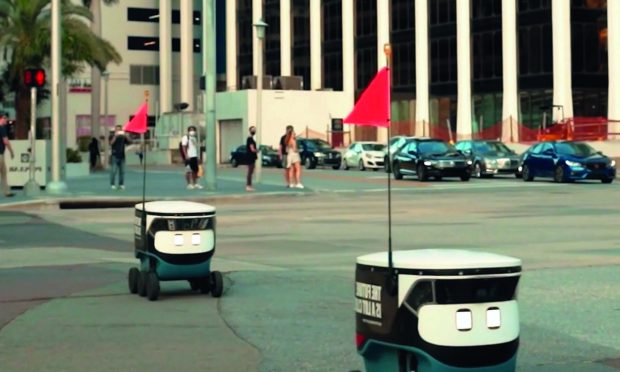Grubhub Gears Up for Full Rollout of Campus Delivery Robots

As food delivery businesses look to make the economics of the model more efficient, Grubhub is rolling out autonomous delivery at college campuses.
The aggregator announced Monday (June 13) that, after a spring pilot test at Ohio State University, the company is making its partnership with self-driving robotics company Cartken available to colleges across the country. The aggregator has existing partnerships with over 250 U.S. college campuses.
“Robot delivery is exciting for students and helps provide even better service and innovative solutions to our campus partners,” Eric Harper, senior director of campus environments at Grubhub, said in a statement. “We look forward to supporting our university partners and responding to their unique delivery environments as we roll out this technology at other campuses in the coming months.”
Grubhub’s competitors have also been leveraging robotics to automate the delivery process. The United States’ leading restaurant aggregator, DoorDash, for one, discussed its autonomous delivery efforts in a company announcement issued in November of 2021.
“Over the last several years, we’ve tested warehouse automation solutions and drones, partnered with industry players like Starship Technologies, Marble Robot, and Cruise Automation,” Stanley Tang, the company’s co-founder and chief product officer and Harrison Shih, its director and head of product at DoorDash Labs, wrote in the company blog post. “Our goal is to facilitate automation across the most repetitive part of delivery and ensure the best experience for Dashers.”
Similarly, one of the world’s leading aggregators, Uber Eats, announced in mid-May the launch of two robotic delivery pilot tests, one in partnership with driverless vehicle technology company Motional and one with autonomous sidewalk delivery company Serve Robotics.
Related news: Uber Eats Launches Two Robotic Delivery Pilots as Restaurant Industry Struggles to Meet Demand
Now, delivery services that are not aggressive in their efforts to integrate automation into the process risk falling behind.
By the Numbers
Aggregators’ driver labor challenges come as demand for restaurant delivery remains high. In fact, about one in three restaurant customers order from delivery aggregators each month, according to data from the March/April edition of PYMNTS’ Digital Divide series, “The Digital Divide: Regional Variations in U.S. Food Ordering Trends and Digital Adoption, created in collaboration with Paytronix, which drew from a survey of more than 2,500 U.S. adults who regularly purchase food from restaurants.
See also: New Research Shows That Regional Dining Quirks Matter in Tailoring Restaurant Offers
What Insiders Are Saying
In an interview with PYMNTS, Wade Allen, senior vice president and head of Innovation at Chili’s parent company Brinker International, spoke to the need for these sorts of tech-powered delivery upgrades.
“Delivery is really inefficient,” Allen said. “It’s a half-ton vehicle. It’s a single person generally taking food somewhere between a mile to two miles. Gas prices are going up. There’s pressure on labor or there’s just a lot of expense in that. It’s really inefficient. So, you start to think about, ‘Hey, is there a smarter way to do this?’”
You may also like: Chili Parent Brinker International Says Automation Is the ‘Heartbeat’ of Innovation
Yet, Ali Kashani, Serve’s co-founder and CEO, contended in an interview with PYMNTS that, even as these sorts of robotic deliveries become more widespread through initiatives such as the Uber Eats partnership, it will nonetheless take time to overcome resistance to the new technology.
“There’s ton of demand already. … It’s just a matter of time. It’s just patience,” Kashani said. “You have to go through this process, put the robots out, take care of the integrations, go through the manufacturing of more robots. It takes time to engage regulators, engage customers. … There’s an education component, making sure people understand why this exists, why it needs to exist.”
Read more: Uber Eats’ Robotic Delivery Partner Serve Takes on Education Barrier
